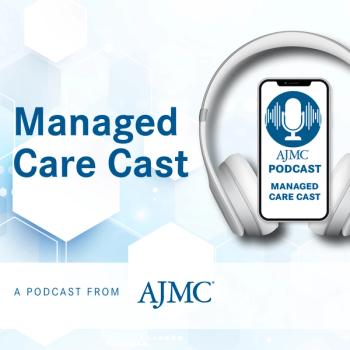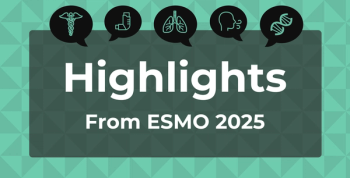
Weighing Osimertinib vs Amivantamab-Lazertinib in Frontline EGFR NSCLC: Danny Nguyen, MD

Amivantamab plus lazertinib enhances survival in NSCLC but requires complex care compared with osimertinib, explained Danny Nguyen, MD, of City of Hope.
Although the combination of amivantamab plus lazertinib in non–small cell lung cancer (NSCLC) offers stronger progression-free survival (PFS) and overall survival benefits, it requires more complex workflows and supportive care than oral osimertinib, explained Danny Nguyen, MD, medical oncologist and hematologist at City of Hope National Medical Center in Duarte, California.
In the
This interview has been edited lightly for clarity.
Transcript
AJMC: Osimertinib is an oral drug, whereas amivantamab is an intravenous formulation. Given those differences in delivery mechanisms, how do physicians need to change up workflows for the amivantamab-lazertinib combination?
Nguyen: Definitely there needs to be some education around the infusion with amivantamab. A lot of the data is looking good in terms of effectiveness—like PFS, overall survival, and everything—but there definitely has to be [recognition] that there are more side effects with the combination regimen. The workflow will have to include not only the physician but also the nurses administering the treatment and the supportive care personnel as well.
There’s prophylaxis we need to implement to help reduce the skin side effects, as well as potential infusion-related reactions. Anticoagulation [is also used] to help prevent blood clots [from the increased] blood clotting risk. There needs to be a little more care around supportive management with the combination. But personally, as a provider, I think it’s worth it to have patients live longer, have their cancer symptoms under control for longer, and have less complications potentially happening from their cancer.
AJMC: Does having a subcutaneous formulation of amivantamab in development maybe change some of these considerations?
Nguyen: I think a lot of providers who may not be too familiar with administering the [intravenous] (IV) form or hear [about] the risk of infusion-related reactions are looking forward to the injectable, which, instead of an infusion that could last hours, it’s more of an injection that goes in over approximately 5 minutes. It seems to help with the infusion-related reactions significantly, [with] some suggestion of improvement in the blood clotting issue.
I still think providers still need to be aware that the on-target side effects of the EGFR and MET are still there. We still need to be proactive with the skin management, regardless of if they’re getting IV or subcutaneous. One of the benefits of just doing an oral therapy monotherapy like osimertinib is that it’s very convenient to give. [The patient doesn’t] need to come to the clinic very often. That benefit is still there. I think the subcutaneous injection can help improve the convenience of giving this combination therapy.
AJMC: You mentioned earlier that
Nguyen: In my mind, we have 3 good options for frontline EGFR patients: osimertinib monotherapy, osimertinib plus platinum-based chemotherapy, or amivantamab plus lazertinib. I think, ultimately, the patient decides which pathway they want to choose. The physician lays out all the treatment options, the pros and cons of each one, and the data behind each one.
Ultimately, the patient does have the final say if they prefer only a single-agent oral therapy for convenience, understanding that the overall survival and PFS benefit is probably not as strong as the combination regimen. If patients wanted longer-term control of their cancer, then I think the combination route would make more sense.
There’s a lot of data on subgroups that seem to benefit more or less from these combination therapies. I think the good thing about amivantamab plus lazertinib is it seems like across all subgroups, there seems to be a benefit regardless. High-risk groups—such as [patients with] liver metastases, brain metastases, positive ctDNA [circulating tumor DNA], or TP53 [mutations]—seem to benefit significantly from the combination. But I think pretty much any EGFR subgroup would benefit from the combination therapy.
Personally, over the past 6 months, I’ve seen different patients deciding to be on all 3 [treatment options]. Some patients are older or frail and just want to be on monotherapy, which is fine. I’ve actually seen some younger patients who also don’t want to be burdened with going to the clinic all the time and also choose monotherapy. I’ve seen older patients choose to be on combination therapy as well. Ultimately, it’s about shared decision-making with the patient, laying out all the data, and understanding that there’s really no right or wrong answer with all 3 of the approved [treatments] in the frontline setting.
AJMC: Would subcutaneous amivantamab be something that patients can do themselves at home for improved patient experience, or do they still need to be in the clinic?
Nguyen: Ultimately, it’s still given in the clinic. Even with the injection, there’s still a potential risk for injection-related reactions and definitely side effects. Although it’s a lot more convenient to give, I still want people to understand—and providers to understand—there are still some side effects that can potentially happen. You have got to monitor closely.
Even with monotherapy osimertinib, you still want to monitor closely because you can get a slew of side effects [we’ve seen] now that we’ve been using it for a few years. Maybe, I can potentially envision, at some point, people being able to give [subcutaneous amivantamab] at home, but right now, because there’s still a risk for some side effects that can happen, it’s probably safer to just give the injection in the clinic and monitor for a period of time. Even when we give subcutaneous amivantamab here, we’re still monitoring for a period just to make sure patients are doing okay.
Newsletter
Stay ahead of policy, cost, and value—subscribe to AJMC for expert insights at the intersection of clinical care and health economics.







































